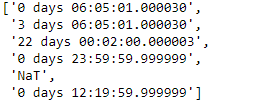Python Pandas TimedeltaIndex.format
Python是一种进行数据分析的伟大语言,主要是因为以数据为中心的Python包的奇妙生态系统。Pandas就是这些包中的一个,它使导入和分析数据变得更加容易。
Pandas TimedeltaIndex.format()函数渲染给定TimedeltaIndex对象的字符串表示。
语法: TimedeltaIndex.format(name=False, formatter=None, **kwargs)
参数 :
name:名称
返回:数组
示例#1:使用TimedeltaIndex.format()函数来呈现给定TimedeltaIndex对象的字符串表示。
# importing pandas as pd
import pandas as pd
# Create the TimedeltaIndex object
tidx = pd.TimedeltaIndex(data =['3 days 06:05:01.000030', '1 days 06:05:01.000030',
None, '1 days 02:00:00', '21 days 06:15:01.000030'])
# Print the TimedeltaIndex object
print(tidx)
输出 :

现在我们将使用TimedeltaIndex.format()函数为给定对象渲染一个字符串表示。
# renders string representation to the index
tidx.format()
输出 :

正如我们在输出中看到的,TimedeltaIndex.format()函数返回了一个类似于数组的对象,其中包含了字符串形式的tidx的所有元素。
示例#2:使用TimedeltaIndex.format()函数来呈现给定TimedeltaIndex对象的字符串表示。
# importing pandas as pd
import pandas as pd
# Create the TimedeltaIndex object
tidx = pd.TimedeltaIndex(data =['06:05:01.000030', '3 days 06:05:01.000030',
'22 day 2 min 3us 10ns', '+23:59:59.999999',
None, '+12:19:59.999999'])
# Print the TimedeltaIndex object
print(tidx)
输出 :

现在我们将使用TimedeltaIndex.format()函数为给定对象渲染一个字符串表示。
# renders string representation to the index
tidx.format()
输出 :

正如我们在输出中看到的,TimedeltaIndex.format()函数返回了一个类似于数组的对象,其中包含了字符串形式的tidx的所有元素。
 极客教程
极客教程